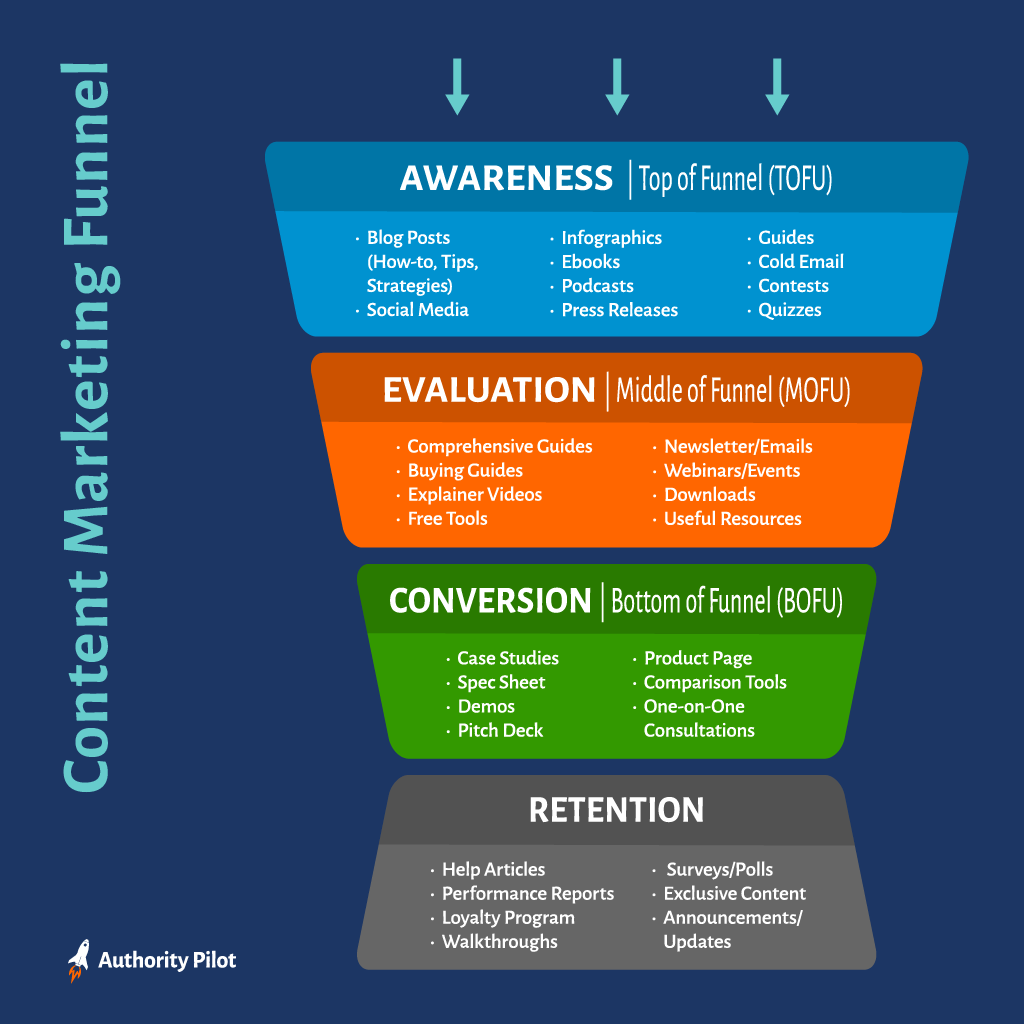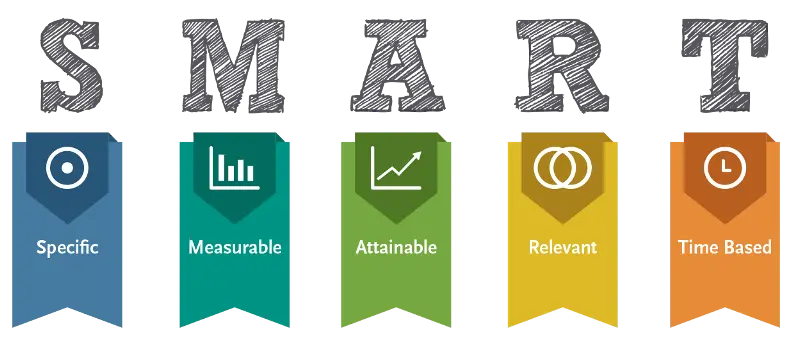
Many businesses struggle to create a content marketing strategy that consistently drives traffic, generates leads, and strengthens their brand. Without a clear direction, marketing efforts often become disorganized, leading to wasted resources and missed opportunities. The frustration of low engagement rates and minimal conversions can leave even the most dedicated teams questioning their approach.
This guide will show you how to develop a content marketing strategy that aligns with your goals and captures your audience’s attention. From identifying your target audience to crafting personalized marketing messages, we’ll provide actionable steps to create a plan that delivers measurable results and sets your brand apart.
Understanding the Content Marketing Funnel
To create a successful content marketing strategy, it’s important to understand the journey your audience takes, from discovering your brand to becoming loyal customers. The content marketing funnel breaks this journey into four key stages: Awareness, Evaluation, Conversion, and Retention. Each stage requires tailored content to guide your audience seamlessly through the process.
- Awareness (Top of Funnel – TOFU): At this stage, potential customers are just discovering your brand. Content like blog posts, infographics, social media updates, and guides help raise awareness and attract attention.
- Evaluation (Middle of Funnel – MOFU): Here, your audience is comparing options and looking for more detailed information. Resources like buying guides, explainer videos, and free tools help build trust and demonstrate value.
- Conversion (Bottom of Funnel – BOFU): This is where prospects become customers. Case studies, product pages, and consultations encourage action by addressing their final concerns and offering solutions.
- Retention: Beyond the initial conversion, retaining customers is essential. Help articles, surveys, and exclusive updates ensure ongoing engagement and loyalty.
The following infographic visually illustrates these stages and the types of content that work best for each one:

Developing a Target Audience
Successful content marketing begins with a clear understanding of your target audience. This means analyzing demographics and psychographics to build detailed buyer personas. The aim is to customize your content strategy to match audience needs, fostering brand growth and generating leads.
Understanding Demographics
Demographics are the measurable characteristics of a population that provide important insights into the makeup of your target audience. These data points allow businesses to segment their audience into specific groups, making it easier to create marketing messages that resonate with them. By understanding key traits such as age, gender, income, and location, you can align your content strategy to meet the unique needs, preferences, and behaviors of your customers.
For example, age ranges can guide the tone and style of your messaging, while geographic locations might shape regional campaigns or time-sensitive offers. Gender and income levels can influence which products or services you highlight, and factors like education and occupation help determine the complexity and language of your content. Using these insights leads to a more focused marketing approach, improving engagement and building stronger relationships with your audience.
Here are some key demographic factors to consider:
- Age
- Gender
- Income Level
- Education
- Occupation
- Geographic Location
Understanding these demographic factors is essential for creating a focused and effective content marketing strategy. Below is a table summarizing key demographic data to guide your approach:
| Factor | Description |
|---|---|
| Age | Range of ages within the target audience |
| Gender | Male, Female, Non-binary, Other |
| Income Level | Low, Medium, High |
| Education | High School, Bachelor’s, Master’s, PhD |
| Occupation | Various job titles and industries |
| Geographic Location | Cities, States, Countries |
For more detailed guidance on creating a content marketing strategy template, consider how these demographic insights contribute to our overall plan.
Analyzing Psychographics
Psychographics look at the deeper side of your audience, like their interests, values, attitudes, and how they live their daily lives (Vertical Response). By understanding these things, you can create content that feels more personal and keeps people interested. Some important psychographic factors include:
- Values and Beliefs
- Interests and Hobbies
- Lifestyle Choices
- Personality Traits
- Behavior Patterns
Understanding psychographics helps us create marketing messages that connect with people on a deeper, more emotional level. Below is a table that highlights key psychographic information:
| Factor | Description |
|---|---|
| Values and Beliefs | What the audience holds important or sacred |
| Interests and Hobbies | Activities they enjoy in their free time |
| Lifestyle Choices | Daily habits, wellness, and health practices |
| Personality Traits | Extroverted, introverted, adventurous, cautious |
| Behavior Patterns | Online shopping habits, brand loyalty |
By blending demographic and psychographic insights, we can build detailed buyer personas that shape our content marketing strategy. This customer-focused approach helps improve marketing results and ensures our content genuinely connects with the audience. For additional tips on creating detailed personas, explore our content marketing strategy examples.
A clearly defined target audience is the foundation of an effective content marketing strategy. Use these insights to sharpen your approach and create content that captures attention and drives results.
Crafting Marketing Messages
Strong marketing messages are key to connecting with your audience and building lasting relationships. Let’s look at personalization strategies and multi-channel engagement to strengthen your content marketing approach.
Personalization Strategies
Personalization in marketing means customizing messages to match individual preferences, behaviors, and demographics. This approach makes content more relevant to the audience, boosting both engagement and conversion rates.
Data-Driven Personalization
Using data from market research, social media analytics, and ongoing feedback helps us create personalized marketing messages. By analyzing this information, we can better understand our audience’s preferences and behaviors, making it easier to customize our messages effectively.
| Personalization Strategy | Description | Example |
|---|---|---|
| Demographic Segmentation | Adjusting messages based on age, gender, or income. | Running ad campaigns targeted at specific age groups. |
| Behavioral Segmentation | Personalizing content based on past activities. | Suggesting products based on browsing history. |
| Psychographic Segmentation | Aligning messages with values or lifestyles. | Developing content focused on sustainability for environmentally conscious audiences. |
Dynamic Content
Dynamic content adapts to user data, offering a personalized experience for each individual. This includes customized email subject lines, tailored content recommendations, and website features that adjust to match a user’s behavior.
To learn more about crafting dynamic and personalized messages, take a look at our B2B content marketing strategy.
Multi-Channel Engagement
Connecting with your audience across multiple channels helps increase visibility and create varied touchpoints. Building a clear strategy that integrates social media, email, and search engines is key to success.
Social Media
Social media is a great tool for connecting with your audience and sharing content. Eye-catching headlines and appealing images can boost shares, comments, and likes (Azura Magazine). Tracking these engagement metrics provides useful information to shape future content strategies.
| Social Media Channel | Key Metrics |
|---|---|
| Likes, shares, comments | |
| Retweets, likes, mentions | |
| Likes, comments, shares |
Check out our social media content marketing strategy article for tips on improving engagement on social platforms.
Email Marketing
Email is still a key way to communicate directly with your audience. Using personalization and segmentation in email campaigns can boost open rates and click-through rates. Tracking performance metrics helps improve email content over time.
SEO and Website Content
SEO plays a key role in any successful content marketing strategy by improving online visibility and driving organic traffic. Techniques like link-building and creating high-quality, expert content help search engines recognize your site as a reliable source of information, which strengthens your domain authority (Forbes).
Building links from reputable websites signals credibility to search engines, making it easier for your content to rank higher in search results. Partnering with high-authority sites or collaborating with industry influencers can amplify this effect, boosting your content’s reach and visibility even further. Additionally, focusing on on-page SEO elements, such as optimizing keywords, meta descriptions, and headings, ensures that your content aligns with user search intent, increasing the chances of attracting and engaging the right audience.
For additional strategies on enhancing SEO through quality content, visit our seo content marketing strategy.
Creating Buyer Personas
Knowing your target audience is the starting point for any successful content marketing strategy. A great way to do this is by creating detailed buyer personas. These personas allow you to customize your marketing efforts to address the unique needs of your audience, leading to better engagement and higher conversion rates.
Detailed Persona Development
Building detailed buyer personas requires collecting and analyzing information about both current and potential customers. This includes demographics, psychographics, behaviors, and motivations. Well-rounded personas provide a deeper understanding of your audience, helping you develop a more targeted content marketing strategy framework.
Some essential components of a detailed buyer persona include:
- Demographics: Age, gender, income level, education, and occupation.
- Psychographics: Interests, values, lifestyle, and attitudes.
- Behavioral Data: Buying habits, spending patterns, and brand interactions.
- Pain Points: Challenges and issues they face that our product or service can address.
- Goals and Aspirations: Long-term and short-term objectives of our audience.
Here’s an example table detailing a buyer persona for a business owner:
| Persona Element | Data |
|---|---|
| Name | “Entrepreneur Emma” |
| Age | 35-45 |
| Occupation | Small Business Owner |
| Education | Bachelor’s Degree in Business Administration |
| Interests | Entrepreneurship, Innovation, Networking |
| Pain Points | Limited budget for marketing, attracting new leads |
| Goals | Increase brand awareness, drive more sales |
With these detailed personas, we can develop content that speaks directly to the unique needs and preferences of our audience. This personalized approach improves the overall impact and success of our campaigns.
Customer-Centric Marketing
Customer-focused marketing prioritizes providing value by addressing the audience’s specific wants, needs, and preferences. Using detailed buyer personas, we can create campaigns that resonate directly with our customers. This strategy helps boost engagement, build trust, and nurture lasting relationships.
Here are a few ways to apply a customer-focused marketing approach:
- Personalized Content: Create content that directly addresses the unique challenges and interests of your buyer personas.
- Multi-Channel Engagement: Connect with your audience through various platforms like email, social media, and blogs to meet them where they are most active.
- Feedback and Refinement: Regularly collect audience feedback and adjust your personas and content strategies to keep them relevant and effective.
If you’re looking to fine-tune your approach, our article on SEO content marketing strategy explains how to align your content with search intent to boost visibility and engagement.
By developing detailed buyer personas and embracing a customer-focused approach, you can make your content marketing strategy much more effective. This helps you not only attract your target audience but also retain them and turn them into loyal customers.
Email Campaign Optimization
Creating a successful email campaign is a key part of building a strong content marketing strategy. By using personalization and segmentation alongside detailed performance tracking, you can significantly boost engagement and improve customer retention.
Personalization and Segmentation
Personalization and segmentation are essential for sharing content that resonates with your audience. By tailoring messages to meet subscribers’ specific needs and preferences, you can create a more engaging and meaningful experience. Segmentation helps by organizing your email list into groups based on factors like demographics, behaviors, and past interactions.
Key Benefits of Personalization and Segmentation
- Higher Open Rates: Using personalized subject lines and customized content makes emails more likely to be opened.
- Improved Click-Through Rates: Relevant and engaging emails encourage more interactions from recipients.
- Increased Conversion Rates: Targeting specific audience segments allows for stronger calls to action that result in more conversions.
| Segmentation Type | Description | Impact on Campaign |
|---|---|---|
| Demographic | Groups audiences by factors like age, gender, or location. | Enables personalized content tailored to demographic characteristics. |
| Behavioral | Focuses on past purchases or website interactions. | Delivers customized recommendations and special offers. |
| Engagement Level | Categorizes users based on activity levels or email open rates. | Helps create re-engagement campaigns for less active users. |
For additional tips on effective email list segmentation, explore our guide on content marketing strategy examples.
Performance Tracking
Monitoring email campaign performance is crucial for ongoing improvement. Measuring key performance indicators (KPIs) helps identify what’s working well and what could be improved.
Important Metrics for Email Campaigns
- Open Rate: The percentage of recipients who open your email.
- Click-Through Rate (CTR): The percentage of recipients who click on links included in your email.
- Conversion Rate: The percentage of recipients who take the desired action, such as completing a purchase.
- Bounce Rate: The percentage of emails that fail to be delivered to recipients.
Using A/B testing can offer helpful insights by comparing different subject lines, content formats, or calls to action. This helps identify which options work best. Regularly reviewing these metrics allows for continuous improvement and better overall results.
| Metric | Definition | Ideal Range |
|---|---|---|
| Open Rate | % of opened emails | 15-25% |
| Click-Through Rate | % of clicked links | 2-5% |
| Conversion Rate | % completing action | 1-3% |
| Bounce Rate | % undelivered emails | 2-5% |
For more tools and templates to help track and analyze email performance, check out our content marketing strategy template resource.
By leveraging personalization, segmentation, and thorough performance tracking, we can design email campaigns that boost engagement and build lasting customer relationships. These strategies make email marketing a key part of our overall video content marketing strategy and broader growth goals.
Leveraging Social Media
Effectively using social media is key to getting the most out of your content marketing strategy. This includes studying audience engagement and gathering insights to improve your marketing approach.
Analyzing Audience Engagement
Examining audience engagement is an important part of our strategy. Social media analytics provides insight into the interests and behavior patterns of our audience (Vertical Response). Understanding these trends allows us to adjust our content to match their preferences more effectively.
Key metrics to track:
- Likes
- Shares
- Comments
- Clicks
- Conversions
Tables provide an effective way to display engagement data:
| Metric | Platform | Q1 | Q2 | Q3 | Q4 |
|---|---|---|---|---|---|
| Likes | 1200 | 1350 | 1450 | 1600 | |
| Shares | 450 | 480 | 500 | 530 | |
| Comments | 380 | 420 | 460 | 500 | |
| Clicks | 600 | 650 | 700 | 750 | |
| Conversions | 150 | 180 | 200 | 250 |
Tools like Google Analytics, Facebook Insights, and Twitter Analytics allow us to explore these metrics in greater detail. Actively interacting with our social media community is equally important for a successful content marketing strategy. By responding to comments, answering questions, and creating groups or communities, we can build strong relationships with followers, customers, partners, and influencers.
Insights for Marketing Strategies
The insights gathered from audience engagement are extremely valuable for improving our marketing strategies. They help us adjust our messaging and distribution methods to connect with our audience more effectively.
Content Creation:
Social media algorithms prioritize engaging content that aligns with audience interests. Thought-provoking editorials, known for their high shareability, often have the potential to go viral (Azura Magazine).Content Distribution:
Effective content distribution involves using a mix of media types—earned, paid, and owned—to reach your target audience (Oren Greenberg). Striking the right balance between frequency, quality, and engagement is essential for success.Community Engagement:
Cultivating a strong community around your brand helps build loyalty and inspires user-generated content, strengthening your social media presence. Actively engaging through social media groups and communities is a key part of this process (LinkedIn).
Using these insights, we can develop a stronger social media content marketing strategy. This includes producing engaging and informative content, applying effective marketing techniques, and offering incentives to highlight our products or services. These efforts work together to drive leads, conversions, and sales.
To learn more about building a well-rounded approach, check out our content marketing strategy framework.
Components of a Successful Content Strategy
Creating a successful content marketing strategy requires including key elements that lead to success. Let’s explore the value of setting SMART goals and establishing documented action plans.
Setting SMART Goals
To make your content marketing strategy focused and effective, consider setting SMART goals—Specific, Measurable, Achievable, Relevant, and Timely. These goals create a clear plan of action and make it easier to track progress over time.

| SMART Criteria | Description |
|---|---|
| Specific | Goals should be clear and specific, answering the who, what, where, when, and why. |
| Measurable | Goals must have criteria for measuring progress and success. |
| Achievable | Goals should be realistic and attainable. |
| Relevant | Goals should align with broader business objectives. |
| Timely | Goals must have a defined timeline or deadline. |
By defining goals that meet these criteria, we can ensure our content marketing efforts are focused and aligned with our overall business strategy.
Documented Action Plans
Having a documented action plan is essential for outlining the steps needed to reach your content marketing goals. A content calendar is one of the most effective tools for this. By keeping it organized and up to date, you can plan and schedule content creation and distribution activities, ensuring everything is done on time and stays consistent (11outof11).
| Action Plan Component | Description |
|---|---|
| Content Calendar | Organizes content creation, publication dates, and promotional activities. |
| Task Assignments | Allocates roles and responsibilities to team members. |
| Performance Metrics | Highlights key indicators to measure the success of content. |
| Review & Optimization | Sets regular check-ins to evaluate content performance and make improvements as needed. |
Building a content inventory and performing a content audit are key parts of this process. These steps allow us to identify, evaluate, and organize existing content assets, ensuring they align with customer needs and strategic goals (Content Marketing Institute).
A documented action plan enables the team to collaborate effectively on shared objectives and evaluate the success of their efforts. For more support, explore our content marketing strategy template and examples of proven strategies in our content marketing strategy examples section.
Bringing It All Together
Crafting an effective content marketing strategy requires a thoughtful approach that combines understanding your audience, setting clear goals, and leveraging the right tools. By creating detailed buyer personas and tailoring your messaging through personalization and segmentation, you can engage your audience in meaningful ways. Incorporating multi-channel engagement, dynamic content, and regular performance tracking ensures your efforts stay focused and yield measurable results.
From setting SMART goals to building a documented action plan, every step contributes to creating a strategy that drives leads, conversions, and lasting customer relationships. By consistently refining your approach through feedback and analytics, your content marketing efforts can evolve and adapt to changing audience needs.
With the right framework in place, your content marketing strategy becomes more than just a plan—it becomes a roadmap for growth and long-term success. Now is the time to apply these principles, connect with your audience, and make your content work harder for your business!







